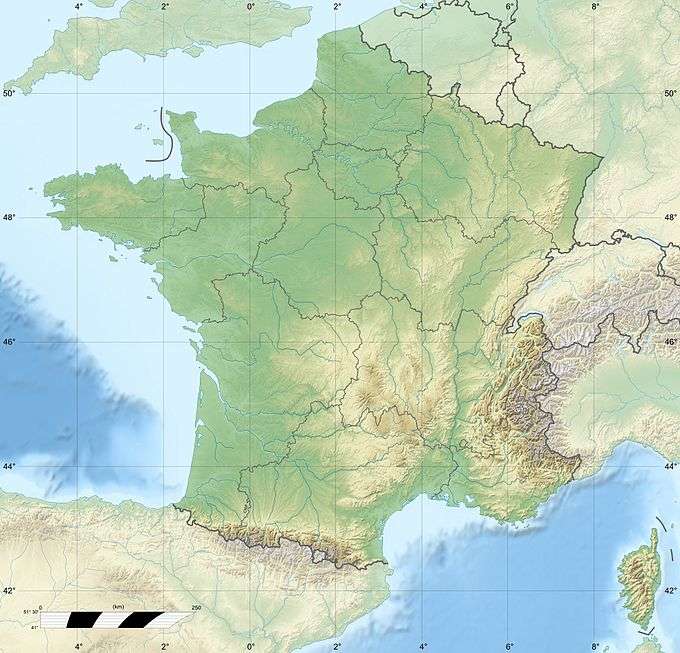CAPC musée d'art contemporain de Bordeaux
|
Lainé warehouse, home to the CAPC | |
 Location within France | |
| Established | 1973 |
|---|---|
| Location | 7 rue Ferrère, Bordeaux, France |
| Coordinates | 44°50′53″N 0°34′18″W / 44.8481°N 0.5718°WCoordinates: 44°50′53″N 0°34′18″W / 44.8481°N 0.5718°W |
| Type | Museum of contemporary art |
| Website |
www |
CAPC musée d'art contemporain de Bordeaux, formerly the Centre d'arts plastiques contemporains (CAPC), is a museum of modern art established in 1973 in Bordeaux, France.
Building
The museum is housed in the Entrepôt Lainé, a former warehouse for colonial goods such as sugar, coffee, cocoa, cotton, spices and oils. The warehouse was built in 1820 by the architect Claude Deschamps. It is built of brick, stone and wood in a style inspired by Italian architecture. There is a grand nave that is reminiscent of a medieval church and that is used to present temporary exhibitions.[1] The building was restored by the architects Denis Valode and Jean Pistre in the 1980s, the second project that this architectural team had undertaken. Their treatment was unusual for the time, emphasizing shadows and depth.[2]
The designer Andrée Putman renovated the interior. The Café Putnam, named after the decorator, has a minimalist decor of metal, concrete and natural materials such as teak and wicker. It has a terrace.[1]
Centre d'arts plastiques contemporains
In 1965 Roger Lafosse created the Sigma Festival in Bordeaux, an avant-garde festival of visual and performance arts. In 1973 he installed Sigma in the Entrepôt Lainé. The Centre d’Arts Plastiques Contemporains (CAPC) was founded by Jean-Louis Froment. In 1973 CAPC held its first contemporary art exhibition called Regarder ailleurs (Look Elsewhere). By 1974 CAPC had moved into the warehouse.[3]
The first exhibitions included artists such as Gina Pane, Andy Warhol and Christian Boltanski. They quickly established the venue as one of the leading places dedicated to contemporary visual arts.[1] Two theater companies joined Sigma and CAPC, as well as the architecture center Arc en rêve. CAPC presented new avant-garde work in group exhibitions, and was gradually discovered by the public.[3]
Musée d’art contemporain
In 1983 the institution became the CAPC Musée d’art contemporain de Bordeaux (Bordeaux Museum of Contemporary Art). The museum was formally opened on 17 May 1984. During the 1980s the museum put on many exhibitions and events, and also arranged exhibitions in California, Spain and then throughout Europe and Japan with the exhibition of the Sonnabend Collection. In 1990 the CAPC Musée and the arc en rêve architecture center occupied the entire warehouse, which was reopened after renovations in June 1990. In the years that followed the museum has steadily added to its collection, with assistance from the state. The focus was enlarged from Europe and North America to cover work from Asia, South America and emerging countries. In 2003 the museum was designated a National Museum of France.[3]
The CAPC museum presents permanent exhibitions of its collection and organizes large temporary exhibitions on specific themes. It often features artists who work in the Bordeaux region. Since 2000 the museum has frequently been used for exhibitions of music, architecture, cinema, literature or design, and has often put on exhibitions of popular art.[1]
Directors
- Jean-Louis Froment, 1973–96
- Henry-Claude Cousseau, assisted by Marie-Laure Bernadac, 1997–2000
- Maurice Fréchuret, 2001–06
- Charlotte Laubard, from 2006
References
- 1 2 3 4 Auzias & Labourdette 2012, p. 28.
- ↑ Rambert 2005, p. 8.
- 1 2 3 30 ans d'expos, Bordeaux.
| Wikimedia Commons has media related to Entrepôt Lainé (Bordeaux). |
Sources
- "30 ans d'expos" (in French). Bordeaux. Retrieved 2009-03-12.
- Auzias, Dominique; Labourdette, Jean-Paul (2012-06-19). Les 100 plus beaux musées de France 2012 (avec photos et avis des lecteurs). Petit Futé. ISBN 2-7469-5399-4. Retrieved 2014-12-05.
- Rambert, Francis (2005-01-01). "A Culture of Use Specific Design". Valode and Pistre Architectes. Images Publishing. ISBN 978-1-920744-53-3. Retrieved 2014-12-05.